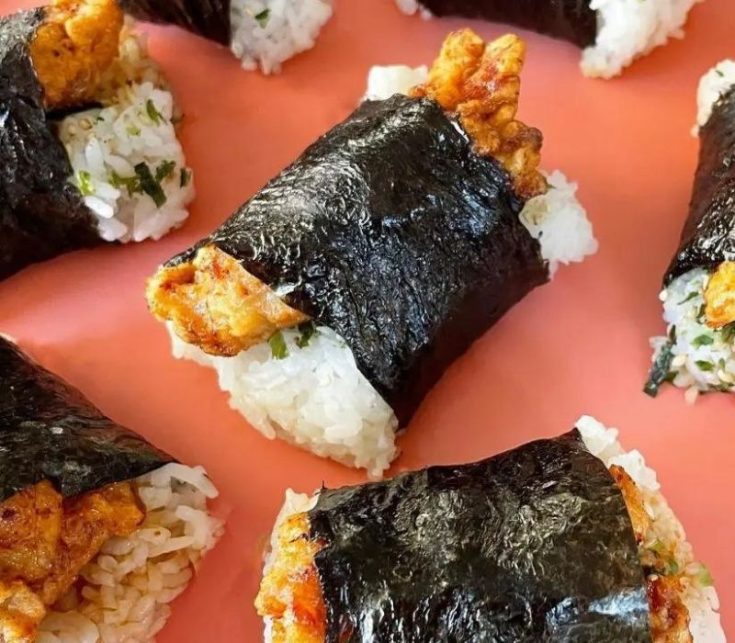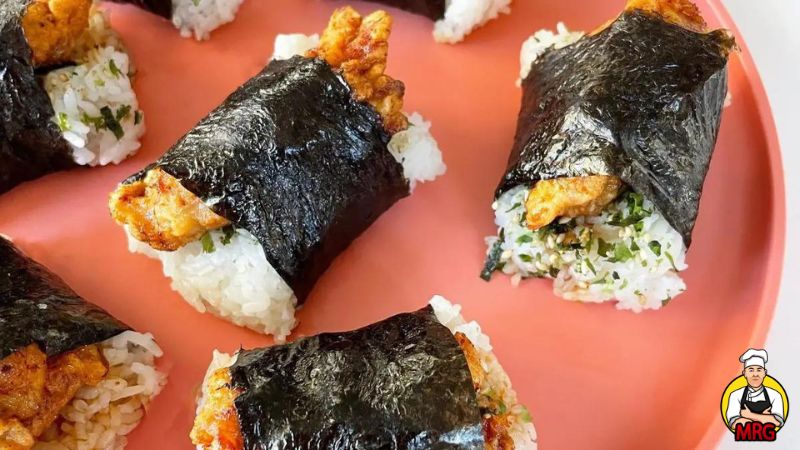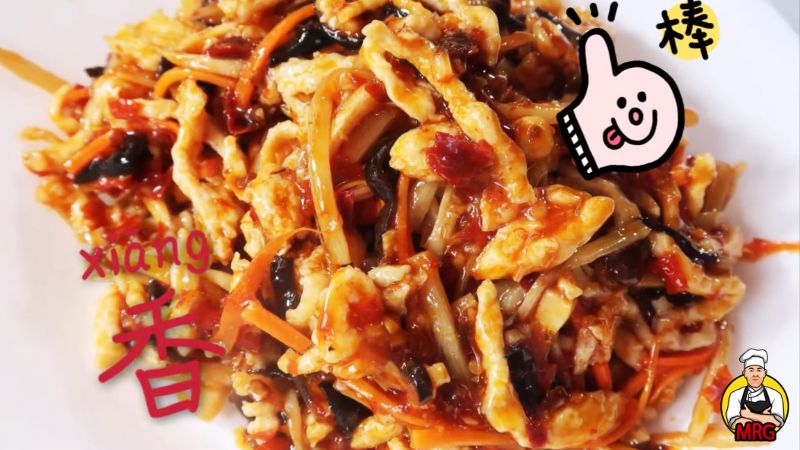When the word “Musubi” arises, it might spark images of a sushi-like block of rice and Spam wrapped in seaweed. But today, we’re about to explore a flavorful variant – Musubi Chicken, a fascinating fusion of Pacific Islanders and Asian American culinary traditions. As a devoted food blogger and passionate home cook, I have been charmed by this delightful dish and its ability to transform simple ingredients like chicken, rice, nori seaweed, and teriyaki sauce into a masterpiece.
Musubi Chicken: The Taste of Culinary Adventure
Musubi Chicken is an appealing symphony of flavors that will transport your taste buds on a delicious journey. It’s a beautiful interplay between the succulent, teriyaki-glazed chicken that provides a savory and sweet profile, and the perfectly cooked Japanese rice that offers a sticky, neutral base. Enveloping this divine duo is the crisp nori seaweed sheet, lending a subtle, briny undertone to each bite. Trust me, once you take that first bite, you’ll be hooked.
The Right Equipment: Crafting Musubi Chicken
To create your Musubi Chicken at home, you don’t need a plethora of equipment. A non-stick pan for pan-frying your chicken, a rice cooker for preparing your Japanese rice, a small saucepan for the teriyaki sauce, and a musubi press for shaping are sufficient. A musubi press is a specific tool used to shape the rice perfectly but if you can’t find one, don’t worry. Any clean, rectangular object will do just fine.
Your Recipe to Deliciousness: Musubi Chicken
Musubi Chicken

Musubi Chicken captures the essence of Hawaiian-Japanese fusion in every bite. The melding of succulent teriyaki-glazed chicken with perfectly cooked Japanese rice, all wrapped in a crisp sheet of nori, evokes a delightful dance of flavors on the palate. It's a nostalgic reminder of island vibes and a testament to culinary innovation.
Ingredients
- 2 boneless chicken breasts
- 2 cups of Japanese rice
- 4 sheets of Nori seaweed
- Teriyaki sauce (store-bought or homemade)
- 2 tablespoons of cooking oil
- 1 teaspoon of salt
Instructions
- Start by cooking your Japanese rice according to the instructions on the package. While it cooks, pan-fry your boneless chicken breasts with a bit of oil and salt until golden and cooked through.
- Once the chicken is cooked, glaze it generously with teriyaki sauce, letting it simmer for a few minutes to allow the flavors to meld.
- Cut your nori seaweed sheets into strips wide enough to wrap around your musubi.
- Assembling the Musubi: Wet your hands and the musubi press to prevent the rice from sticking. Press a layer of rice into the bottom, add a layer of teriyaki-glazed chicken, and then top it with another layer of rice. Press it firmly to compact the layers.
- Remove your musubi from the press, and wrap a strip of nori seaweed around it, sealing it with a dab of water.
- Repeat the process until all your ingredients are used up.
Nutrition Information:
Yield:
6Serving Size:
1Amount Per Serving:Calories: 430Total Fat: 10gSodium: 900mgCarbohydrates: 60gFiber: 2gSugar: 10gProtein: 25g
Serving Suggestions and Suitable Side Dishes
Musubi Chicken can be enjoyed as a hearty snack, appetizer, or a meal, depending on the portion size. It pairs wonderfully with a simple side salad using romaine lettuce or any other crunchy greens. Alternatively, it can be served with other Asian street foods such as Korean Corn Dogs, Chicken Siopao Asado, or Beef Siomai for an Asian-inspired feast.
For a healthier alternative, replace the white Japanese rice with brown rice or quinoa, and pair it with a mixed vegetable stir-fry.
Cooking Tips and Common Mistakes to Avoid
- When pan-frying chicken breast, make sure your pan is hot enough to seal in the juices and ensure a nice, golden color.
- Don’t skip toasting the nori seaweed sheets. Toasting them lightly over an open flame gives a smoky flavor that pairs beautifully with the other ingredients.
- Always wet your hands and musubi press before shaping to prevent the rice from sticking.
- Avoid overfilling your musubi press with rice or chicken. It makes wrapping with nori seaweed difficult and could result in a mess.
Conclusion:
From Guam to your kitchen, creating Musubi Chicken can be a delightful culinary journey, introducing you to new flavors and techniques. So, roll up your sleeves, gather your ingredients, and get ready to create this masterpiece.
As Saif Al Deen Odeh, a culinary enthusiast and expert, says, “Cooking is about experimenting, sharing, and creating memories, one dish at a time.” This Musubi Chicken will undoubtedly be a memorable addition to your cooking repertoire.
FAQs
Can I use Spam instead of chicken?
Yes, you can use Spam to create a Spam Musubi, which is the more traditional form of this dish.
Can I reheat Musubi Chicken?
Yes, you can reheat it in the microwave for a minute or two. However, it’s best consumed fresh.
Is there a vegetarian alternative?
Absolutely! You can replace the chicken with tofu or any preferred plant-based protein.
Where can I find Nori Seaweed Sheets and Japanese Rice?
These can typically be found at any Asian grocery store.
Can I make my own Teriyaki Sauce?
Yes, making teriyaki sauce at home is quite simple and allows you to control the sweetness and thickness to your preference. Check out our “Making Teriyaki Sauce” post for a comprehensive recipe.
What if I don’t have a Musubi press?
No problem, you can use any clean, rectangular object, like a Spam can.
What is Musubi Sauce made of?
Musubi sauce is typically a blend of soy sauce, sugar, and sometimes sake or mirin. It’s a sweet and savory concoction that complements the flavor of the rice and the filling. Many liken it to teriyaki sauce, but it can vary in its sweetness and consistency.
What does Musubi mean in Hawaiian?
In Hawaiian, “musubi” translates to “sandwich” or “to tie.” It’s fitting given the compact, sandwich-like appearance of musubi and how the nori seaweed ties everything together. This delightful snack has deep roots in Hawaiian culture, often enjoyed as a convenient and delicious meal option.
What does Musubi taste like?
Musubi offers a delightful combination of tastes and textures. The Japanese rice is sticky and slightly sweet, the fillings (like our Musubi Chicken) are savory and flavorful, and the nori wrapping provides a hint of oceanic saltiness. The overall taste is a balance of sweet, salty, and umami, making it a favorite for many.
Are there different types of Musubi?
Yes, there are various types of musubi! While the most popular is Spam musubi, a myriad of fillings can be used, ranging from chicken, as in our recipe, to fish, shrimp, avocado, or even traditional pickled ingredients. The possibilities are endless, allowing for continuous culinary creativity with this Hawaiian staple.
Related Article:
I’m Calvin Lamb, an LA-based culinary enthusiast with a decade’s experience in five-star kitchens. My innovative dishes, inspired by seasonal flavors and sustainable practices, blend classic and modern cuisine. Besides crafting unique culinary experiences, I relish exploring new eateries and devising fresh recipes.



